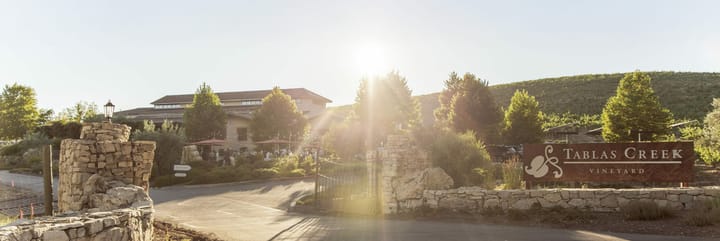Veraison 2025: Slow and Steady Wins the Race
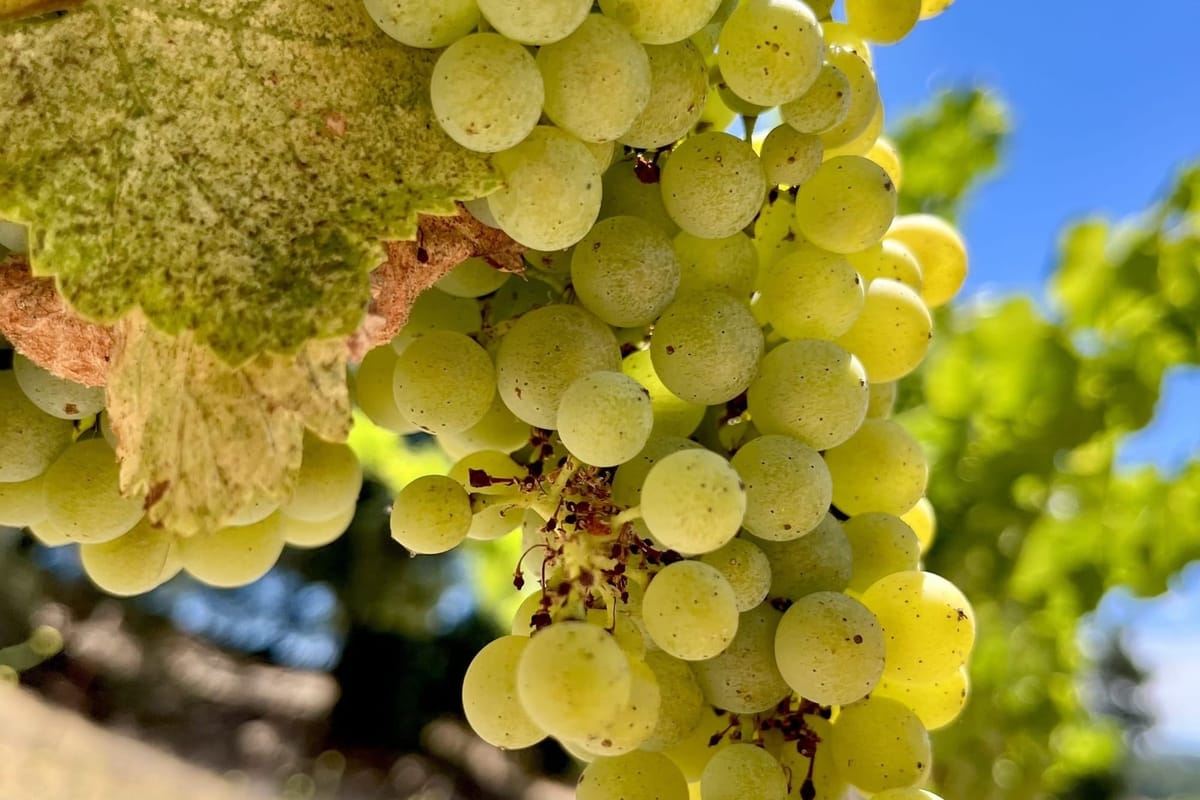
Veraison, if you're unfamiliar with the term, is a physiological stage of grape development where the berries stop accumulating mass and start accumulating sugar. More visibly, red grapes start their color change from green, while white grapes take on more of a yellow tint. Both red and white grapes start to soften. The onset of veraison comes roughly six weeks before the beginning of harvest, and gives us our best estimate for what sort of schedule we're likely looking at. And it's lovely. Witness these Syrah clusters, roughly halfway through veraison as of this morning:
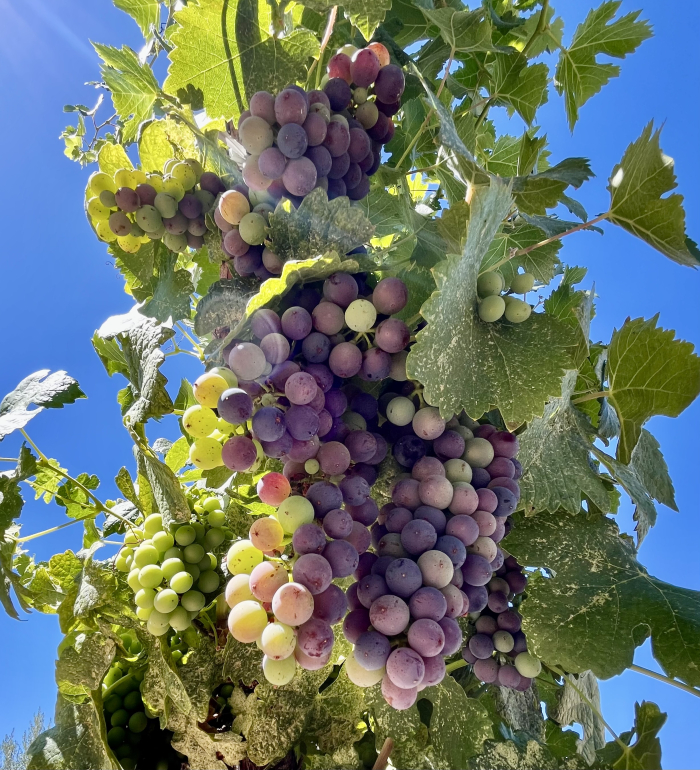
This summer has been lovely and moderate. We've only had two days over 100°F, by far our fewest in recent years. Our average high in July, typically the warmest month of the year here, was just 87.8°F, more than 10°F cooler than July 2024 and 8°F cooler than even our famously-cool 2023 vintage. Even as we've turned to August, we're regularly seeing morning marine layer fog lifting as we arrive for work. It makes for a beautiful beginning to our days:
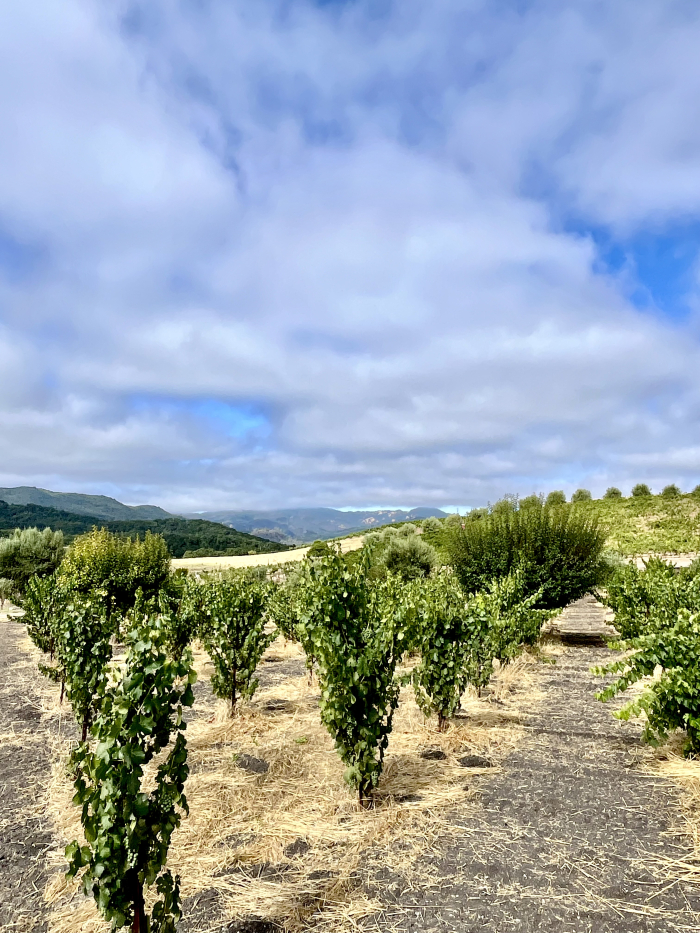
One useful way of measuring the amount of heat a vintage has dealt with is cumulative degree days, essentially how many hours a location has seen above a certain threshold, typically indexed to the crop's growing needs and for grapevines around 50ºF. You can see how this year is in some ways a mirror-image of 2024, which began quite cool and in late June became quite hot. This year began moderately warm and has become moderately cool, which means that at our peak in early June we were tracking 18% ahead of 2024 in degree days, and now we're 14% behind:
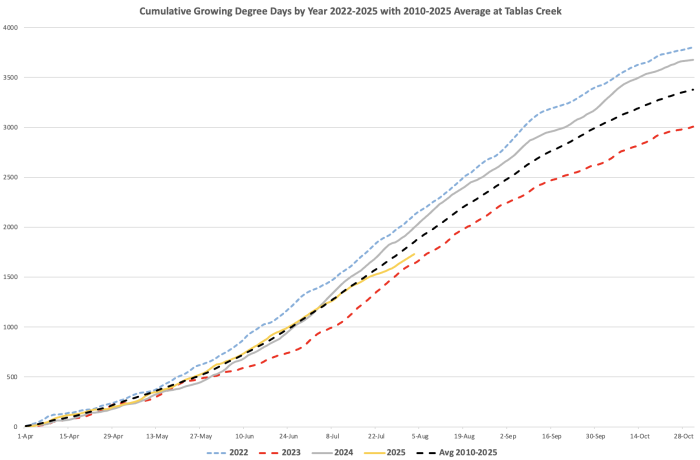
So if it's been so moderate, why am I writing about veraison at the same time as we were in 2024, and a full two weeks earlier than 2023? Because not all heat is created equal. It's not just how much heat you have that determines how fast your grapes ripen. It's how many hours they spend in prime ripening temperatures between 75°F and 95°F. And this year has been perfect. Last year, we saw 15 July days top 100°F. Even in 2023, 11 July days topped the century mark. This year, it's only happened once. Those very hot days aren't great for ripening, because above 95°F grapevines start to close the pores in their leaves and slow or stop photosynthesizing to protect themselves from dehydration. Episodes of extreme heat also sap the vines' vigor, which can have negative effects later in the growing season. So what we saw in June and July was ideal: the mornings started cool, the grapevines never had to stop photosynthesis in mid-afternoon, and we've stored up energy for the final push.
Since the calendar flipped to August, we've seen peak ripening conditions, with each day topping out in the mid-90s°F (average: 94.8°F) and each night dropping into the upper 40s°F (average low 47.2°F). And the vines seem ready to make the turn toward home, with colors developing by the day. I thought I'd take a quick romp through our core red Rhone varieties to give you a sense of where each stands. At the end, I've included a chart with how this year compares to other recent years and made some predictions about when we're likely to start picking.
We spotted our first color in the vineyard in Mourvedre on July 23rd. That's a little surprising, as it's typically late to most of the markers (budbreak, flowering, and ripeness). But it can be early to veraison, and this year it actually came in first. I'm still not expecting to start picking it before October, but it feels appropriate to kick off the veraison blog with a photo of what we're seeing right now. This cluster is a little more advanced than the average, and I'd estimate that we're at about 40% veraison in Mourvedre overall:
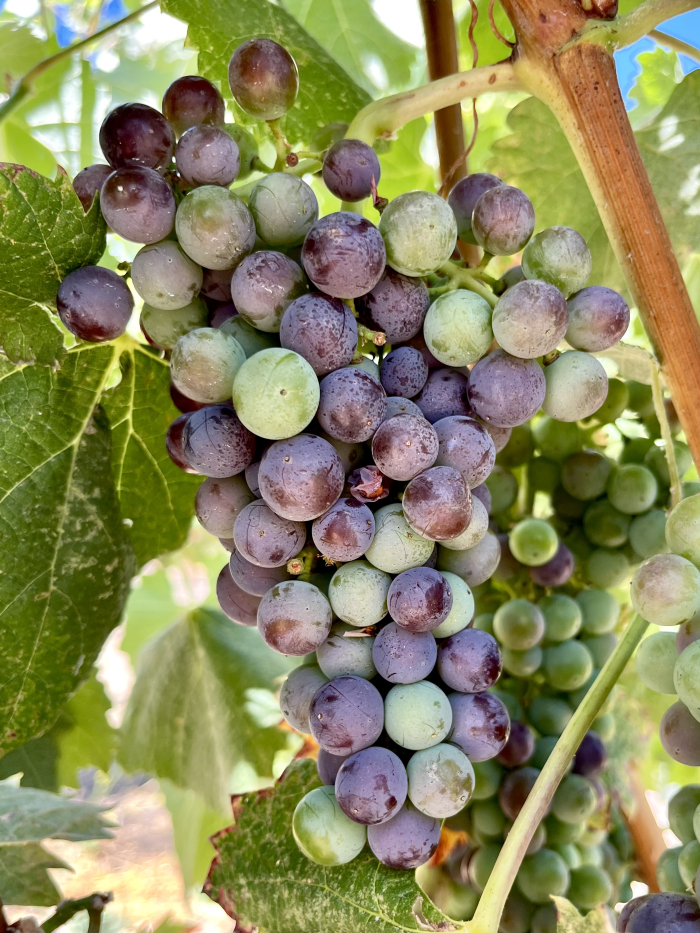
The clusters with the most dark color are Syrah. That isn't a surprise; Syrah is the fastest grape to change colors, and I expect it to be the first estate red grape into the cellar in mid-September. The clusters below are pretty reflective of the average in the vineyard, and I'd estimate that we're probably around 50% through veraison in Syrah overall:
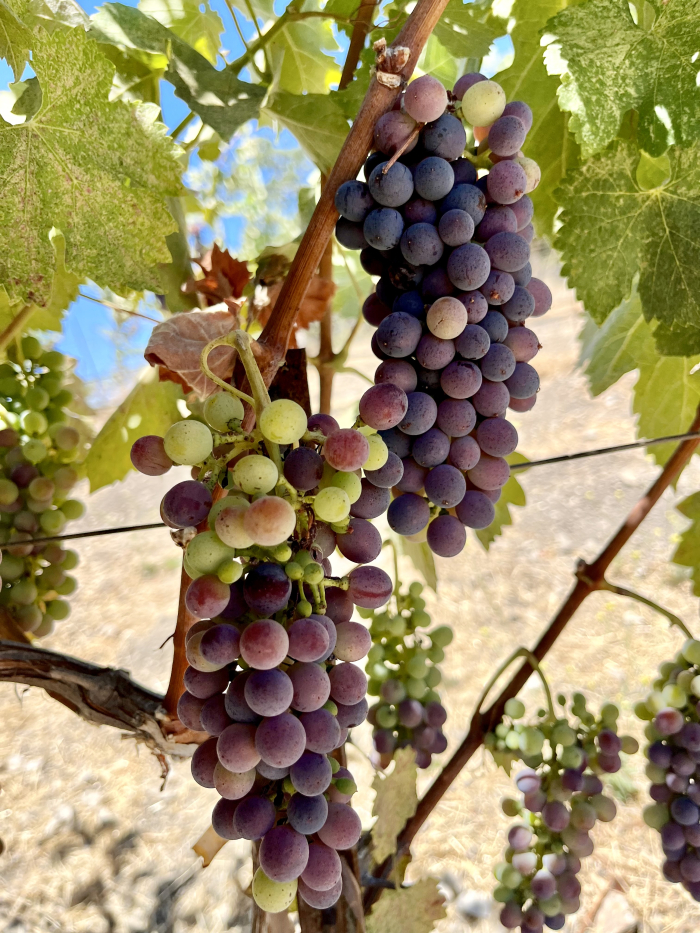
Grenache has been slow to enter veraison this year. There are still entire blocks that remain green, and only at the tops of the hills do we see much color change. I look forward to sharing lots more Grenache photos with you in coming weeks; it's always a particularly pretty grape to watch change color, with the berries turning jewel-like in the sun. But for now, I'd estimate that we're only around 5% veraison:
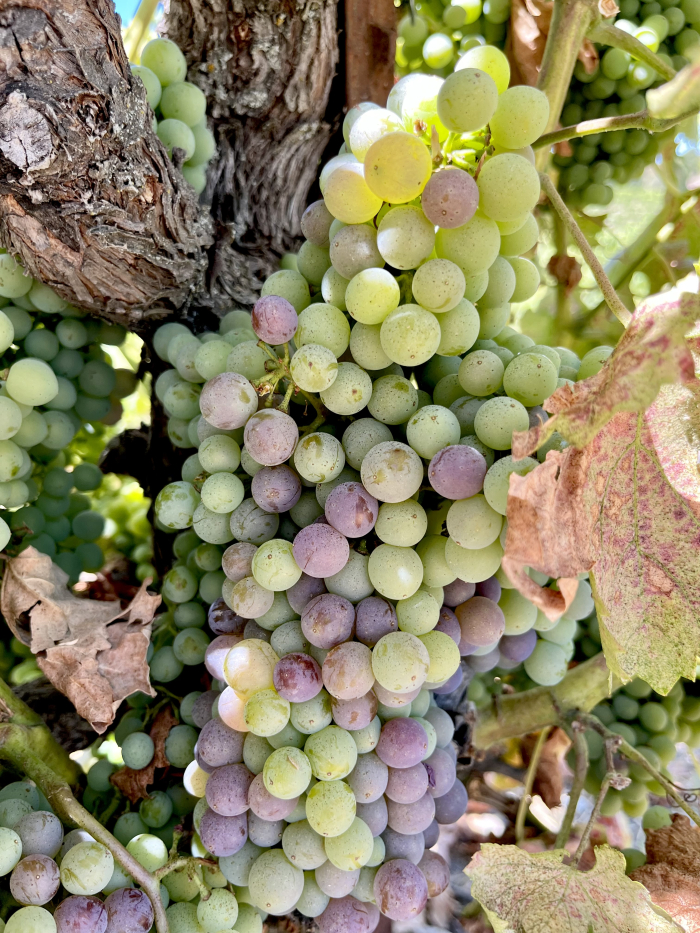
It took some searching to find any color in Counoise. This cluster, with a few plum-colored berries in a sea of green, is about as advanced as it gets. I'd estimate we're around 2% on Counoise, overall:
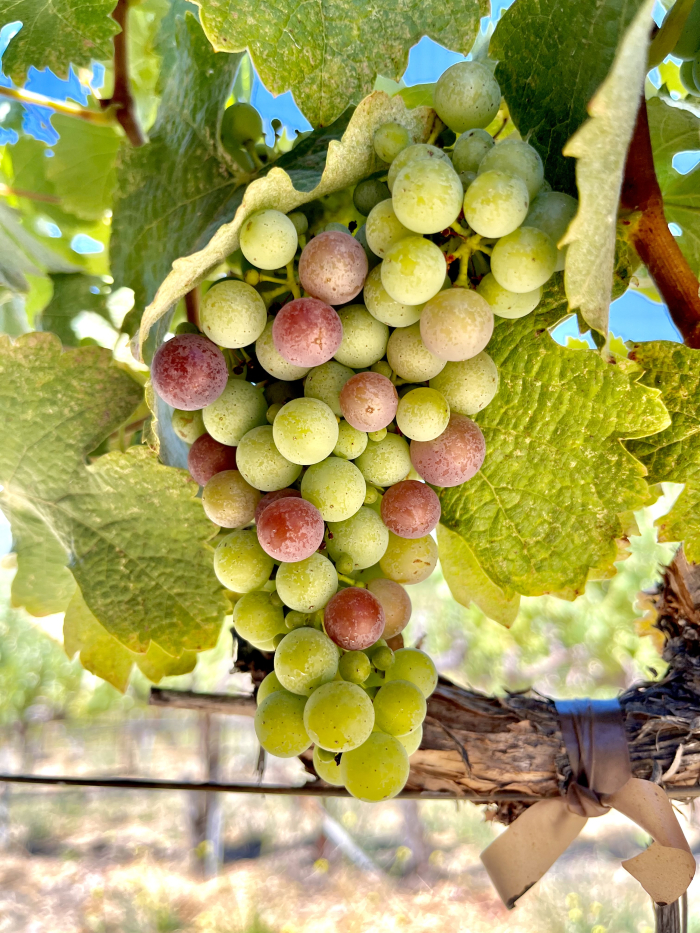
Finally, Cinsaut. We are learning that although Cinsaut is not a super late ripener, coming in pretty much in synch with Grenache, it is slow to enter veraison. Perhaps if we had any Cinsaut blocks on the tops of our hills I'd have been able to find some color, but we don't. One block is in the middle of a hill and the other in a valley. So, all I have to show you for a Cinsaut cluster is one that's still resolutely green:
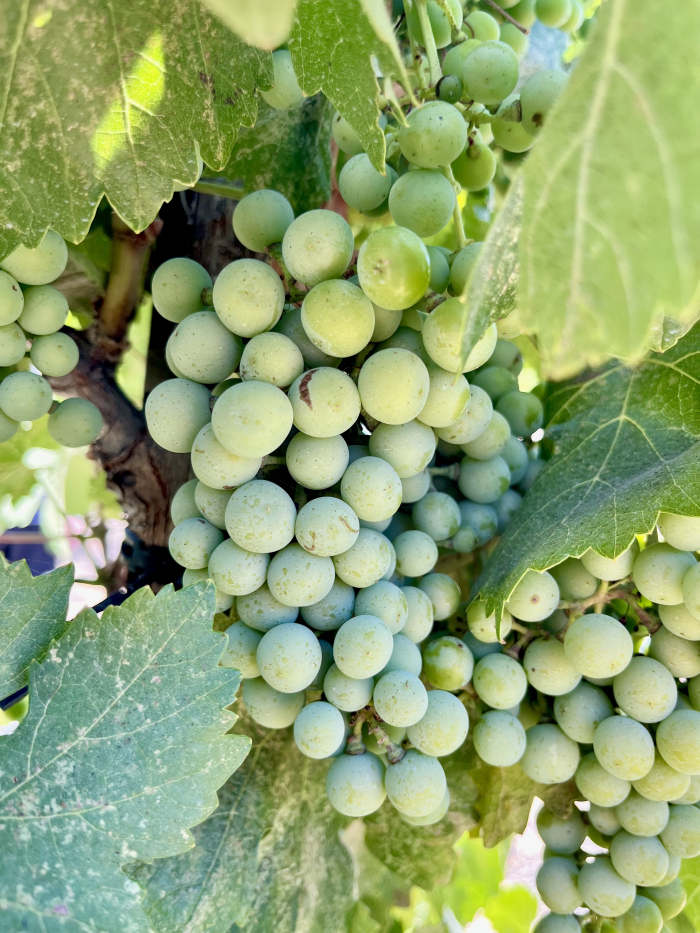
While I didn't hit every vineyard block today, the other reds would be somewhere within this continuum as well. Muscardin tends toward the early side like Syrah, while Terret Noir is later like Counoise, and Vaccarese is very late, like Cinsaut. And although it's less exciting visually than with reds, white grapes too go through veraison. The grapes turn from green to something a little yellower, and soften and start to get sweet. They also become more translucent. The process happens over a similar time frame as the reds. Viognier goes first, followed by Vermentino, Marsanne, and Grenache Blanc, with Picpoul and Roussanne bringing up the rear. You can see the slightly golden tone that the below cluster of Grenache Blanc is starting to show:
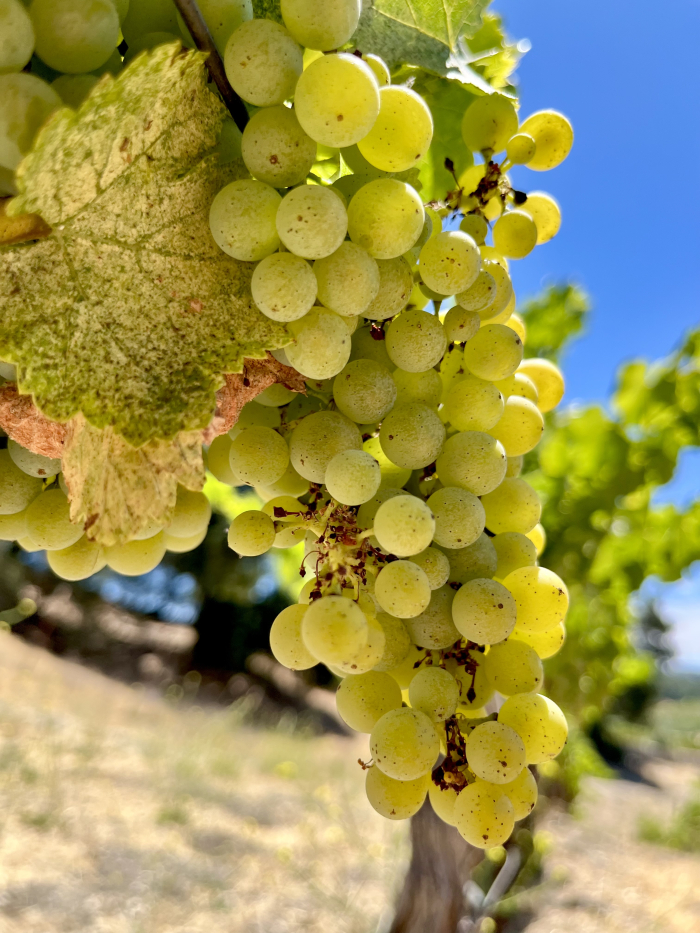
While the veraison posts you're likely seeing from your favorite wineries may make it seem like veraison is a moment, like Christmas, it's better to think of it as a season, like winter, and first veraison is like first frost, or first snowfall. It will likely be a few weeks before even all the Syrah clusters at Tablas are red, and more than six weeks until the last clusters of later grapes like Mourvedre and Counoise have finished coloring up.
While six weeks is a good basic guide for the duration between the onset of veraison and the beginning of harvest, it's not totally constant, and will be influenced by the weather that we get in the interim, as well as by the amount of fruit the vines are carrying and the inherent tendencies of the different varieties. For example, a consistently cool summer and a plentiful crop in 2010 gave us a full seven weeks between veraison and our first harvest, while last year's consistent heat and low yields gave us just a five week interim. Each vintage since 2010 is compiled in the chart below, with each year linked to my blog post about that year's veraison:
| Year | First Veraison Noted | Estate Harvest Begins | # of Days |
|---|---|---|---|
| 2010 | July 30 | September 16 | 49 |
| 2011 | August 5 | September 20 | 47 |
| 2012 | July 25 | September 5 | 42 |
| 2013 | July 17 | August 26 | 40 |
| 2014 | July 9 | August 23 | 45 |
| 2015 | July 18 | August 26 | 39 |
| 2016 | July 13 | August 18 | 36 |
| 2017 | July 20 | August 30 | 41 |
| 2018 | July 29 | September 10 | 43 |
| 2019 | July 30 | September 4 | 36 |
| 2020 | July 21 | August 25 | 35 |
| 2021 | July 21 | August 24 | 34 |
| 2022 | July 12 | August 17 | 36 |
| 2023 | August 7 | September 14 | 38 |
| 2024 | July 24 | August 26 | 33 |
| 2025 | July 23 | ? | ? |
Using the range of durations between first veraison and first harvest (33 to 49 days) we can have good confidence that we'll begin picking sometime between August 25th and September 9th. The weather between now and then will determine where in the range we'll fall, influenced as well by the crop levels, since lighter crops ripen faster than heavier ones. It looks like we're seeing medium crop levels this year, better than the last few years but not at the levels we saw in a year like 2017, which suggests we'd trend toward the middle of the range above. But the lovely weather we've had has produced excellent vine health and canopies for this stage in the year, which means that if August continues like it has started, the vines could make a lot of progress quickly. When I'm asked, I'm guessing we'll start the first week of September. But time will tell.
What's next for the vineyard? We'll watch the different grapes go through veraison. That progress is already happening fast, and the view in the vineyard is changing daily. We'll be posting regular photos of veraison's progress on our Facebook and Instagram pages. In a few weeks, we'll start sampling the early varieties, looking for the moment when the flavors are fully developed and the balance of sugars and acids ideal. In the cellar, we've been working to finish blending our 2024 reds. Next we'll pull out, clean, and check all the tanks and equipment we'll need once harvest begins. It's likely too that we'll see some grapes from Patelin or Lignée vineyards, and from the Haas Vineyard Pinot Noir, before anything comes off our estate. Those grapes should start coming in around the end of the month.
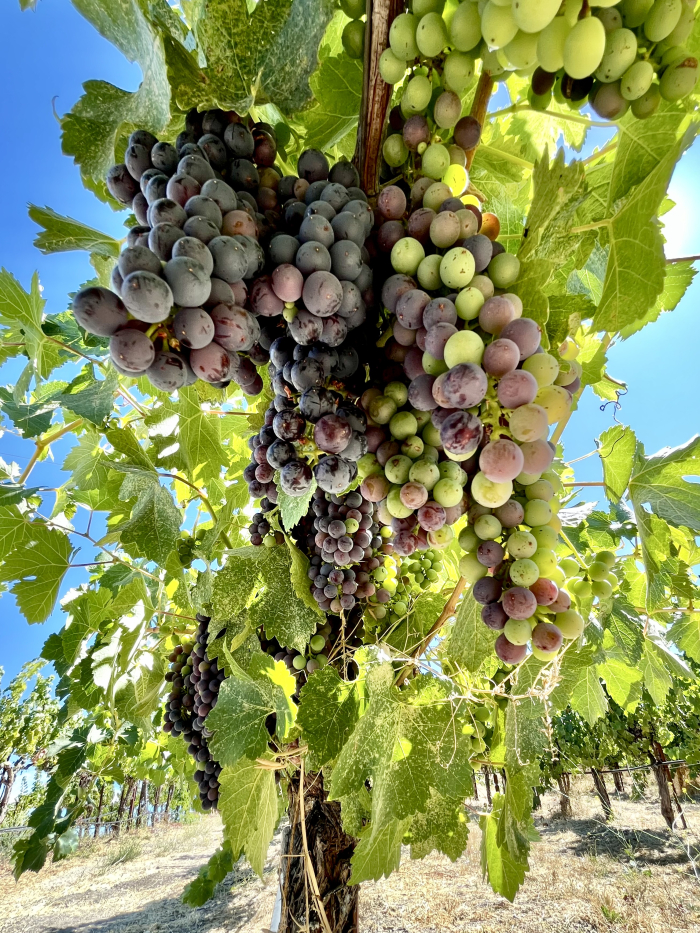
So, now we wait, and enjoy the show, with our best idea yet of when the curtain goes up.

